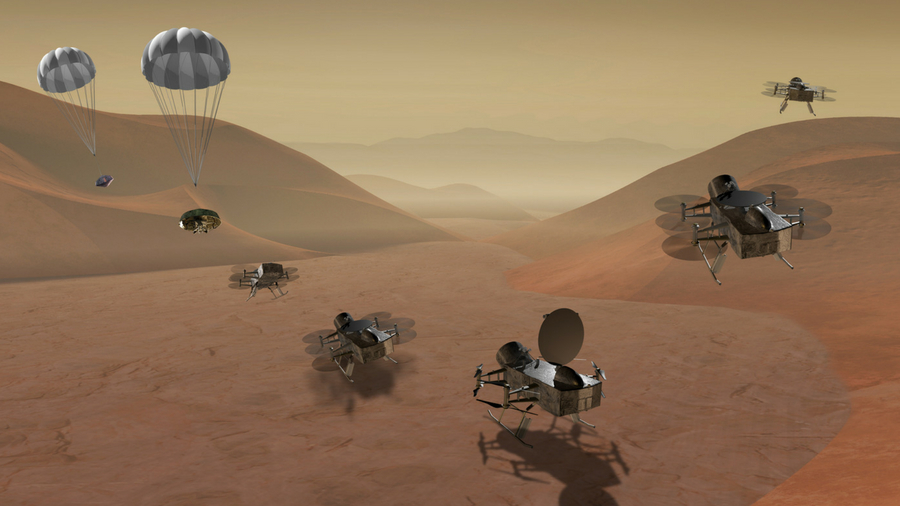INSUBCONTINENT EXCLUSIVE:
Image credit: NASA/JPL-CaltechNot even 12 miles
That's how far NASA's beloved Curiosity rover has traveled across the surface of Mars in its six years at the Red Planet.It's time for a
marscopter.NASA has announced that a Mars Helicopter, a small autonomous rotorcraft, will travel with the agency's Mars 2020 rover mission
blades will attempt to cut the thin Martian atmosphere at just shy of 3,000 rpm, which is about 10 times the rate of a helicopter on
and as powerful as it can possibly be," said Aung.However, the Mars Helicopter is not the only audacious concept for space exploration
In fact, it's not even the only drone destined to explore another world.Look, no joystickThe Mars Helicopter will be a 'high risk'
If it works well, it could quickly become a standard issue instrument on Mars missions.Dragonfly: Titan Rotorcraft LanderWhile flying in the
competitor within NASA's New Frontiers Program, Dragonfly will have no trouble at all keeping buoyant in the dense atmosphere in Titan,
Titan would require new technology), Saturn's largest moon has been landed on once before, in 2005 by the Cassini spacecraft's tiny Huygens
probe.It took some spectacular footage and sent back a few atmospheric measurements, but the mission only had the battery power for 2.5
hours of data transmission
If selected by NASA, Dragonfly would launch in 2025 and reach Titan in 2034.Aurora Station's 'orbital property'Want to see the Northern
However, it gets a little more expensive than that, with a standard 12-day journey actually costing US$9.5 million per person.'Space
low-Earth orbit 200 miles above the Earth's surface, traveling around the globe once every 90 minutes
That means about 16 sunrises and sunsets in every 24-hour period.However, if that does get dull, there will also be VR headsets and
scoff at projects like the Aurora Station, the International Space Station's long-term future is in doubt, and projects like these could
prove invaluable to state-owned space agencies to conduct a zero gravity research on a lower budget.As well as taking up space tourists and
Earth," said Frank Bunger, CEO of Orion Span
be the last time anyone views China's space policy with anything but envy.Having landed its Chang'e 3 probe and Yutu rover on the moon in
2013, China looks set to send Chang'e 4 to the far side of the moon later this year, specifically to its South Pole, which may contain the
water required for a lunar base
And that's exactly what China is planning.It appears that China's National Space Administration has ambitions to both explore the moon and
use it as a launchpad for manned Mars missions.China's Yutu moon rover could one day get company | Credit: CASC/China Ministry of
to the video, though it also mentioned the exploration of the moon's North Pole as well as its South Pole.With NASA seemingly unable to
produce any momentum or funding for a return to the moon, it seems that lunar exploration will be left to China
However, there are suggestions that the proposed 'lunar palace' could be constructed with the help of the European Space Agency (ESA).The
proposed Comet Astrobiology Exploration Sample Return (CAESAR) mission wants to determine its origin and history by collecting 100g of
NASA)It's the latter objective that has surely sparked the interest of those at NASA, whose New Horizons team currently has its OSIRIS-REx
spacecraft on the way to do a similar job at the asteroid Bennu
It will reach its target in December this year, and attempt to return a sample to Earth in 2023.Scheduled for launch in 2024, the
solar-powered CAESAR's samples wouldn't arrive back on Earth until 2038
sample of a comet to study would give astronomers insight into how these materials contributed to the early Earth, including the origins of
the Earth's oceans, and possibly of life itself.H9qPkDHqbo8bUw5CkjxfJG.jpg#

